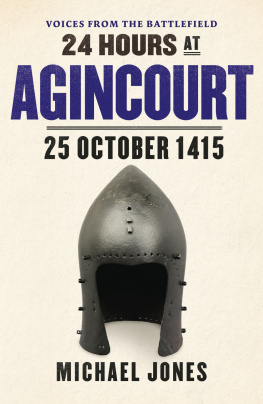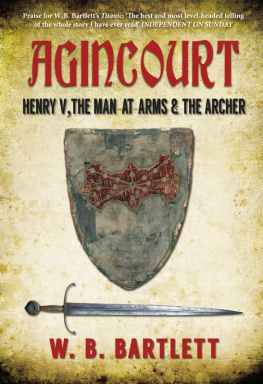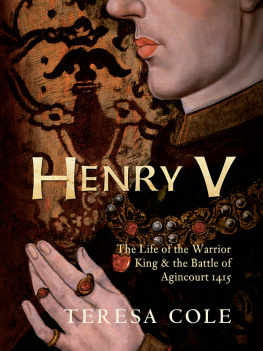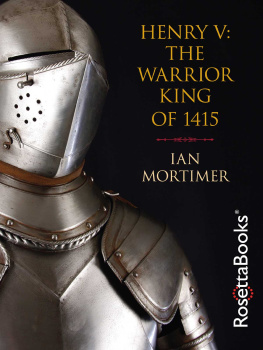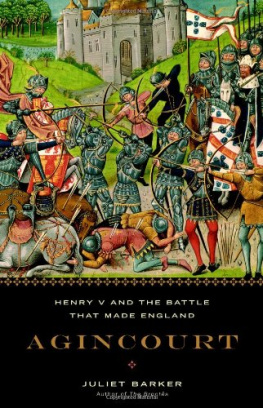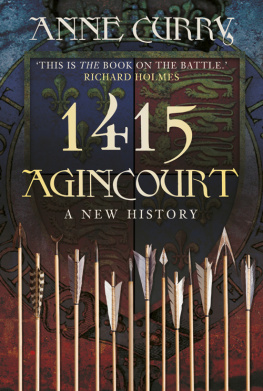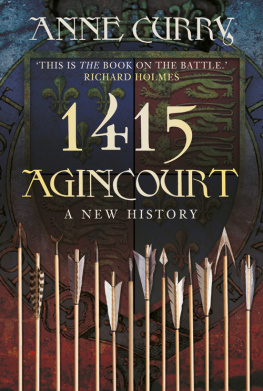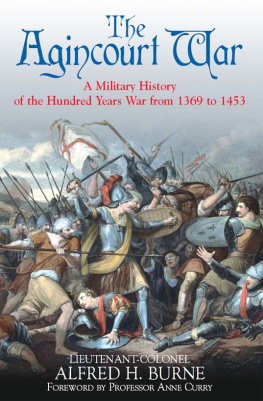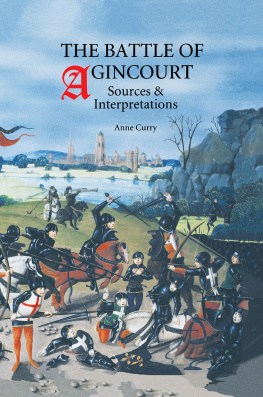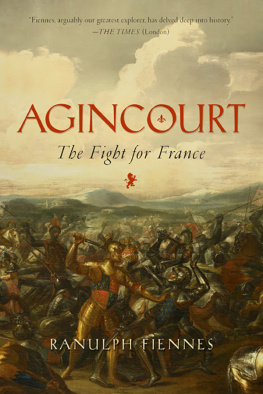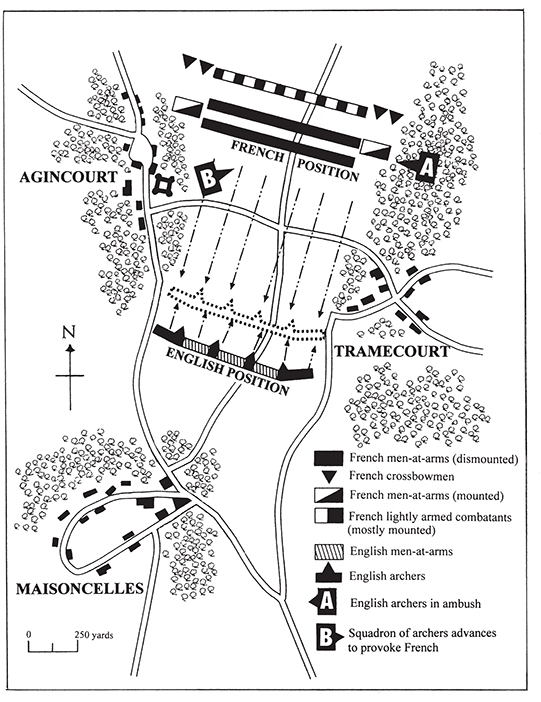Contents
1. The Ridge
The Rival Armies Come into View
14.0016.00 (24 October 1415)
2. No Way Out
The Rival Commanders
16.0020.00 (24 October 1415)
3. The Mud Bath
The Armies
20.0024.00 (24 October 1415)
4. Well Met by Moonlight
Battle Tactics
24.0006.00 (25 October 1415)
5. Breakfast at Agincourt
Motivation and Morale
06.0008.00 (25 October 1415)
6. A Touch of Harry in the Morning
Battle Ritual
08.0009.00 (25 October 1415)
7. The Field of Battle
Terrain
09.0011.00 (25 October 1415)
8. Banners Advance!
The Armies Close In
11.0011.30 (25 October 1415)
9. Impact!
The Mle
11.3012.00 (25 October 1415)
10. Bowmen of England
The Rout
12.0013.30 (25 October 1415)
11. A Band of Brothers
The Victory
13.3014.00 (25 October 1415)
About the Book
Agincourt was an astonishing clash of arms, a pivotal moment in the Hundred Years War and the history of warfare in general.
In August 1415, King Henry V claimed the throne of France and landed an army in Normandy. Two months later, outside the small village of Agincourt in Picardy, he was preparing for certain defeat. On 25 October his exhausted, starving and ailing troops faced a far larger French army, whose soldiers were fresh for combat and determined to destroy their opponents. But what was to take place in the following 24 hours, it seemed only the miraculous intervention of God could explain.
Interlacing eyewitness accounts, background chronicle and documentary sources with a new interpretation of the battles onset, acclaimed military historian Michael Jones takes the reader into the heart of this extraordinary feat of arms. He brings the longbowmen and knights to life, portrays the dilemmas of the commanders and shows the brutal reality on the ground, as archers seized swords, daggers and even mallets to beat their opponents, and heavily armoured men-at-arms sank into knee-deep mud in a bloody fight that astounded the courts of Europe.
About the Author
Michael Jones was awarded a PhD in history by Bristol University and subsequently taught at the University of Glasgow and Winchester College. He is a fellow of the Royal Historical Society and member of the British Commission for Military History and works now as a writer, media consultant and presenter. Amongst his historical titles he has written on the battles of Bosworth, Stalingrad and Leningrad and co-authored The Kings Grave: The Search for Richard III. He was a consultant on Channel 4s Battle of Agincourt and The History Channels Warriors.
Also in the series
24 Hours at Waterloo by Robert Kershaw
24 Hours at the Somme by Robert Kershaw
(to be published in May 2016)

This ebook is copyright material and must not be copied, reproduced, transferred, distributed, leased, licensed or publicly performed or used in any way except as specifically permitted in writing by the publishers, as allowed under the terms and conditions under which it was purchased or as strictly permitted by applicable copyright law. Any unauthorized distribution or use of this text may be a direct infringement of the authors and publishers rights and those responsible may be liable in law accordingly.
Epub ISBN: 9780753550496
Version 1.0
1 3 5 7 9 10 8 6 4 2
WH Allen, an imprint of Ebury Publishing,
20 Vauxhall Bridge Road,
London, SW1V 2SA
WH Allen is part of the Penguin Random House group of companies whose addresses can be found at global.penguinrandomhouse.com

Copyright Michael Jones 2015
Michael Jones has asserted his right to be identified as the author of this Work in accordance with the Copyright, Designs and Patents Act 1988
First published by WH Allen in 2015
www.eburypublishing.co.uk
A CIP catalogue record for this book is available from the British Library
ISBN 9780753555453
Preface
IT IS A pleasure to write this book for the 600th anniversary of Agincourt. The sequence of 24 hours follows the English and French armies from the moment they first sighted each other, on the ridge northwest of Blangy-sur-Ternoise on the afternoon of 24 October 1415, to the culmination of the battle a day later. In the introduction and early chapters it also allows the reader to become acquainted with the qualities of Henry Vs leadership and the story of the campaign as a whole. Without an understanding of these it is hard to make sense of the battle.
It is important also to mention the three Ts time, testimony and terrain. Agincourt is one of the first major battles for which the 24 hours approach is appropriate: the mechanical clock had been invented in the fourteenth century, and by the early fifteenth most towns, abbeys and palaces had one prominently displayed. Portable timepieces also existed. So it was possible, by 25 October 1415, to tell the time reasonably accurately if a clock was available and if one actually wished to do so.
This form of measurement was known as merchant time, because it was most frequently used in the medieval world of business. The older system, where the day was divided into the eight hours of religious practice (that actually existed at roughly three hourly intervals from prime, at around 6 am, onwards) was known as monastic time, and this form of timekeeping was more general than exact. And along with sundials and water clocks, and at night with candles marked at hourly or three-hourly intervals, people would simply look at the position of the sun or moon in the sky.
This distinction is important because in the fifteenth century people still believed that the outcome of battle lay in the hands of God, and while it might be appropriate to measure time accurately on the approach to combat, it would be unlucky or inappropriate to do so during the actual engagement. Hence, chroniclers and writers of the day largely used the monastic system of time and the position of the sun to delineate the unfolding of events on the battlefield and, as the sources sometimes contradict each other, the timings given in the time-line and the sequence of chapters can only be approximate.
Testimony from a battle makes it come alive for us, and allows us to hear the voices of the participants. At Waterloo, whose 200th anniversary was commemorated in June 2015, a wealth of first-hand accounts, diaries and letters can be drawn upon. But in the late Middle Ages, where letters and diaries were a rarity, and first-hand battle reminiscences infrequent and relatively brief, a tapestry of different sources needs to be stitched together. This book draws on the relatively few eyewitness accounts that survive, the broader battle memory preserved in the chronicles of the time and supporting documentary material alongside the visual evidence of tomb memorials and illuminated manuscripts. The main voices are introduced as the text unfolds, and can also be found for reference in a brief summary (Voices from Agincourt).

